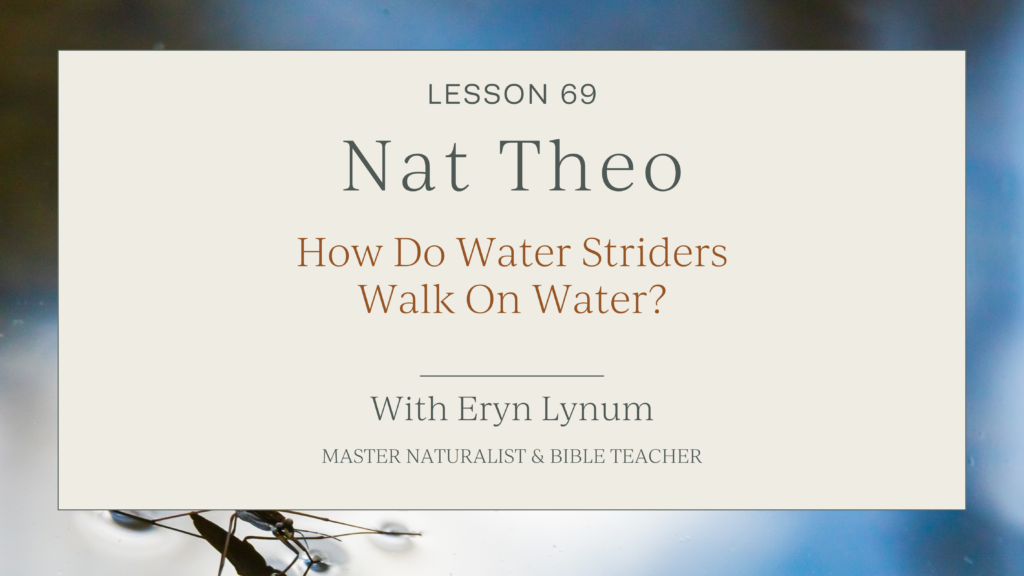How Do Water Striders Walk on Water?
The Nature of Rest
What the Bible and Creation Teach Us About Sabbath Living
Intentional Parenting
Nature Studies
Apologetics
Adventure
Free Resource
Entrepreneurship
Homeschooling
Faith
Books
Categories
Master Naturalist, Bible teacher, author, wife, and mama of four! Join our adventures of discovering God while adventuring in creation.
I'm Eryn
Hey there!


Listen Now






Order now


Water Strider Coloring Sheet
Learning about How Do Water Striders Walk on Water? Make math simple and effective with CTCMath for grades k-12.


How Do Water Striders Walk on Water?
Have you ever seen a creature walking on water? When I was a young girl, I loved watching insects with long legs skittering across ponds. I called them water spiders because they looked like spiders. But they were actually water striders! These fascinating insects go by many nicknames, such as pond skaters or water skippers, because they seem to glide effortlessly across the surface of the water.
Today, we’re going to discover how water striders walk on water, explore the science behind surface tension, and even look at other creatures that God designed with this incredible ability!
What Is a Water Strider?
When I was little, I didn’t know that spiders have eight legs. So I never questioned why the “water spiders” I saw on ponds only had six legs. As naturalists, we’re always on an adventure to better understand God’s creation. By paying attention to small details—like how many legs a creature has—we can start asking great questions and learning more about the world around us.
A water strider is an insect, not a spider. While spiders belong to the arachnid class, water striders are part of the insect class. God designed them very differently from one another, and today we’re going to explore one of the water strider’s most amazing abilities—walking on water!
What Is Water Surface Tension?
Before we talk about how water striders walk on water, we need to understand something important about water itself.
Have you ever done a belly flop into a pool? Or slapped the water with your hand? If so, you probably felt the sting! That’s because of water surface tension.
Water surface tension happens because water molecules stick to each other. If you’ve ever watched raindrops on a car window, you might have noticed how they join together instead of staying separate. This happens because water molecules are naturally “sticky” due to something called hydrogen bonding.
Hydrogen bonding makes water molecules act like tiny magnets. The molecules at the surface of the water pull together tightly, creating a kind of invisible “shield” on top of the water. This surface tension is strong enough for small creatures—like water striders—to stay on top without sinking!
How Do Water Striders Walk on Water?
So how do water striders walk on top of this invisible shield without breaking through?
The answer lies in their incredible legs. Water striders have six legs, and each one is covered in thousands of tiny hair-like structures called microsetae (micro-set-ee).
Microsetae trap air and repel water, making the water strider’s legs completely waterproof! This prevents water from pulling them down. Instead of sinking, their legs press against the surface tension, allowing them to skate across ponds with ease.
These tiny hairs make the water strider’s legs hydrophobic, which means they push against water rather than mixing with it. You’ve probably seen another example of this—oil and water don’t mix because oil is hydrophobic, just like the water strider’s legs!
Along with their special waterproof legs, water striders use each pair of legs for different purposes:
- Front legs: Used to grab prey.
- Middle legs: The longest legs, used like paddles to move forward.
- Back legs: Used for extra thrust and steering.
With this combination of surface tension and specially designed legs, water striders can move quickly across the water’s surface without sinking!
Do Other Creatures Walk on Water?
Water striders aren’t the only creatures that can walk on water! God designed several other amazing animals with this ability:
Fishing Spider
Fishing spiders use their long legs to create small dimples in the water’s surface, which helps them move forward. Like water striders, they also have hydrophobic hairs that repel water. If threatened, these spiders can even dip below the surface and trap air bubbles around their bodies to breathe underwater!
Basilisk Lizard
The basilisk lizard can actually run across water! It moves incredibly fast—using its large feet to create small air pockets that help it stay on top of the water. If it slows down, it sinks and swims away.
Western and Clark’s Grebes
These water birds can run across the water’s surface by taking around 20 steps per second! Their large, flat feet slap against the water, helping them stay above the surface while they move. They mainly do this as part of their mating rituals to impress potential mates!
How Did Jesus Walk on Water?
So far, we’ve explored how four different creatures move across water. But what about Jesus?
In Matthew 14, Jesus’s disciples were in a boat being tossed by strong winds. Suddenly, Jesus came toward them, walking on the water. Let’s read Matthew 14:24-27:
“Meanwhile, the disciples were in trouble far away from land, for a strong wind had risen, and they were fighting heavy waves. About three o’clock in the morning Jesus came toward them, walking on the water. When the disciples saw him walking on the water, they were terrified. In their fear, they cried out, ‘It’s a ghost!’
But Jesus spoke to them at once. ‘Don’t be afraid,’ he said. ‘Take courage. I am here!’”
Peter, one of Jesus’s disciples, asked if he could come out onto the water, too. Jesus invited him, and for a moment, Peter also walked on water! But as soon as he became afraid, he began to sink, and Jesus reached out to save him.
Some people wonder if Jesus used surface tension to perform this miracle. Could He have changed the water’s properties to create extra hydrogen bonds? Maybe! We don’t know exactly how Jesus walked on water, but we do know this—He is God, and He has power over all of nature.
Saint Augustine once wrote, “A miracle is not contrary to nature, but only to what we know of nature.” God knows far more about creation than we ever could. He can use nature in ways we don’t understand. However, we should not over-naturalize miracles, or think they need to fit into natural laws, because God can also go beyond natural laws to do miracles!
God designed some creatures, like water striders and basilisk lizards, to move across the water’s surface. But humans aren’t built to walk on water.
Yet, Jesus did.
And for a moment, Peter did too—until he took his eyes off Jesus.
Just like Peter, we need to keep our focus on Jesus. When we trust Him, we can walk through life with confidence, knowing He has power over all things—including the laws of nature.


learn more
Raising kids stirs something deep in our souls — an innate knowing that our time is finite. Taking my kids outside in creation, I’m discovering how to stretch our time and pack it to the brim with meaning. God’s creativity provides the riches of resources for teaching the next generation who He is and how He loves us. Join our adventure and discover inspiration and resources for refusing rush, creating habits of rest, living intentionally, and making the most of this beautiful life!
I'm Eryn, Master Naturalist, Author, & Bible Teacher
Hey there!


Receive free inspirational resources for refusing rush, creating habits of rest, parenting with intentionality, and teaching our kids who God is through what He has made!
Inspired
Be
Brand + Website by Amarie Lael Design | TERMS & CONDITIONS + PRIVACY POLICY | Copyright 2011 - 2025 Eryn Lynum
Contact
Speaking & media
About
Books
Shop
Videos & Interviews
Email List
Stories
Free Downloads
Resources
Home
@erynlynumauthor


The Nature of Rest
What the Bible and Creation Teach Us About Sabbath Living
Now Available!
Order
X
Signed Copy
Add a Comment